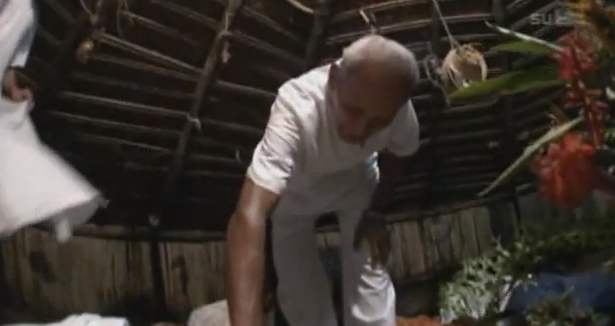“The Amazonian basin is home for 60,000 to 80,000 different plants, many still unknown for their medicinal potential. The medicine ayahuasca is said to heal both psychological and physiological problems, from heroin addiction to Parkinson’s disease. Now, try telling that to the medical industry.” (Source: Riku, Madventures)
In this part of a 2009 episode of Madventures III, the hosts, Riku and Tunna, enter the Amazonian jungle to meet with a local shaman and partake of the medicine brewed from the Amazonian Sacred Vine of the Spirits: AYAHUASCA.
Riku’s aim is to take part in a ritual which will force him to face and defeat his worst fears, by breaking through his own defenses; Tunna anticipates a purifying, cathartic experience that will show him “what his subconsciousness hides.”
The two Madventurers meet with Don Francisco, a 94-year-old local healer, to “guide them between the physical world and the spirit world” at an ayahuasca retreat, where they participate in an ancient ritual with the world’s most powerful hallucinogenic substance (i.e. a Level 5 Psychedelic Experience).
The shaman claims that the visions he gets from ingesting the ayahuasca tell him about the medicinal and spiritual qualities of the plants he uses, saying, “We do as the plants have taught me.”
See what the plants have taught in the full Madventures Ayahuasca journey below (runtime 9minutes 18 seconds).
Ayahuasca is known by 42 different names among the South American people, including yage, mado bidada kamalampi, nishi and oni.
True ayahuasca is created in a shamanic ceremony, brewing liana (Banisteriopsis caapi) and the leaves of the chacruna (Psychotria viridis) plant, which contain the hallucinogen dimethyltryptamine (DMT).
DMT is nature’s own hyper-charged psychotropic substance, which produces far more potent hallucinogenic effects than LSD. The potent hallucinogen is legal for use in Brazil among native tribes and followers of some syncretic religions.
A kind of “dope tourism” has sprung up around DMT, but the substances sold to tourists hoping for a quick high are not true ayahuasca, which can only be produced as a part of the complex shamanic rituals performed by the indigenous Amazonian healers. Riku expounds on this exploitation of the hallucinogenic vine:
“Some gringo hopheads’ growing interest in the namesake has created some mega business around ayahuasca…. All sorts of ‘Honest Juans’ without any real shamanic qualifications… exploit the spiritual reality of the Vine of the Souls.”
The experience is an intense and difficult one for the two spiritual seekers. After swallowing the bitter brew, they spend the night with the shaman and helpers chanting around them, in an overwhelming convolution of hallucinations, violent nausea, vomiting, and fear.

Don Francisco, a 94-year-old healer, guides and comforts Riku and Tunna as they experience fear while under the spell of an authentic ayahuasca experience.
Tunna describes some moments of his experience as thousands of visions, simultaneously looping in and out of each other. He sees a “big storm” of dragons roiling around him, with “big teeth sharp as needles” and horrifying witches, also with needle-sharp teeth that gleam like diamonds. Although he does relate a beautiful vision of his future daughter, Tunna sums up the ayahuasca experience altogether as “Pretty tough, pretty intense. The most horrifying experience I could ever imagine. Pure Hell.”
Riku relates that after the initial fear and violent vomiting, the darkness and chanting around him in the shaman’s hut allows him to “let loose.” He doesn’t feel scared of the “storm of visions and thoughts” as they are assaulting him, although many of them are horrifying things, including seeing his “mother, dead, and the body rotting.” He relates that he just feels curious to watch the horrible things he sees. He sees it as “liberating (himself) from the necessity of being brave.”
After a night of wild hallucinations and a morning of reflection and recuperation, Tunna notes that “This world looks definitely better than the old one,” and Riku sums up the experience:
“Before the moral majority starts foaming at the mouth about another street drug invading the world from South America, no worries. Ayahuasca has nothing to do with that (expletive), nor could it ever be a recreational drug. It’s a medicine of the indigenous tribes here, and an ancient method of therapy still mostly undiscovered by the Western science.”
So if you thought, pure hell could become a recreational street drug once some commercial-minded western dealers got hold of a consistently good ayahuasca recipe–think again, it’s best to just connect on the spiritual path and experience ayahuasca under proper shamanic supervision and guidance.
——-
Click here to continue browsing Ayahuasca TV.
Click here to check out recommended ayahuasca books for some serious ayahuasca scholarship and understanding.
